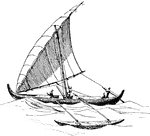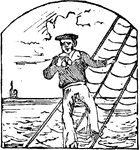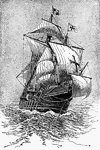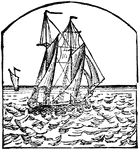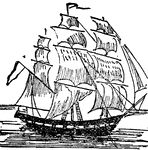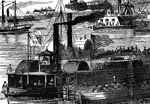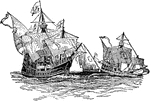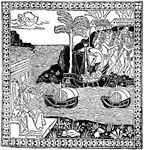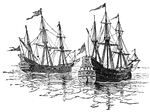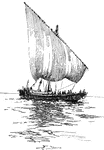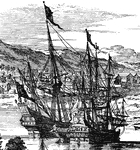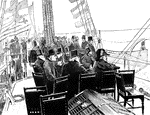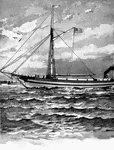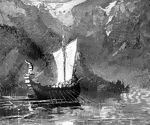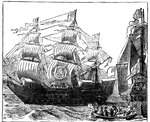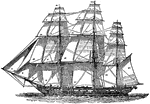
Ship Sails
A piece of cloth or tissue of some kind spread to the wind to impel or assist in impelling a vessel…

Save-All, or Catch-All
"A small sail set under another, or between two other sails, to catch or save the wind." —Whitney,…
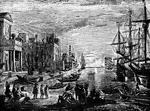
Seaport
This painting by Claude Gelle Le Lorrain happens to be one of the oldest etchings in oil. This painting…

Second Naval Battle
"Second naval battle in Hampton Roads- fight between the Federal ironclad Monitor, of two guns,…
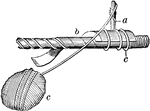
Serving Mallet
"A semicylindrical piece of wood, fitted with a handle...used for convenience in serving ropes...to…
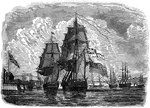
Shannon and Chesapeake Entering Halifax
The Shannon and Chesapeake entering the harbor of Halifax in 1813.
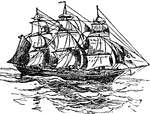
Ship
The name applied in a restricted sense to a large vessel with bowsprit and three masts, each of which…

Ship Building
An image of a ship being built in Spain during the 1400's before Columbus' exploration.

Ship Island
"Ship Island, near the mouth of the Mississippi- United States war steamer "Mississippi" firing on a…
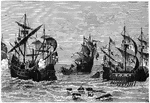
Spanish & English Ships with Sails at War
An illustration of Spanish and English ships with sails at war.
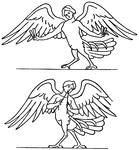
Sirens on a Greek Funeral Marble
"In Greek mythology, one of two, or three, or an indeterminate number of sea-nymphs who by their singing…
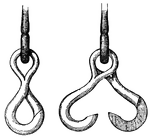
Sister Hooks - Closed and Open
"Nautical, one of a pair of hooks working on the same axis and fitting closely together: much used about…

Sloop
"A small fore-and-aft rigged vessel with one mast, generally carrying a jib, fore-staysail, mainsail,…

Snotter
"A becket fitted round a boat's mast with an eye to hold the lower end of the sprit which is used to…

spanish caravel
A Spanish caravel. The vessels furnished by Isabella were only caravels, light coasting ships,…

Spanish Vessels
This representation of the vessels of the early Spanish navigators is a fac-simile of a cut in Medina's…

St. Louis
"The American Line Steamship St. Louis, launched from the Cramps Docks, November 12, 1894."—E.…

Steamboat of 1736
"A steamboat is a boat or vessel propelled by steam acting either on paddles or on a screw. The term…
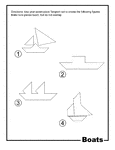
Boats Outline Tangram Card
Outlines of boats (sailboat, ship, yacht) made from tangram pieces. Tangrams, invented by the Chinese,…

Boats Outline Solution Tangram Card
Solutions for outlines of boats (sailboat, ship, yacht) made from tangram pieces. Tangrams, invented…
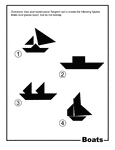
Boats Silhouette Tangram Card
Silhouette outlines of boats (sailboat, ship, yacht) made from tangram pieces. Tangrams, invented by…
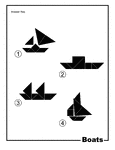
Boats Silhouette Solution Tangram Card
Solutions for silhouette outlines of boats (sailboat, ship, yacht) made from tangram pieces. Tangrams,…

The Victors of Salamis by Fernand Cormon
Illustration of a painting of the ancient Greeks returning victorious from the Battle of Salamis against…

The Spanish Man-of-War Tornado Chasing the American Steamer "Virginius"
American steamship being chased by Spanish man-of-war.

Burning of the White House
"Burning of the White House- the Federal troops, by command of General McClellan, abandoning their position…
Burning of the White House
"Burning of the White House- the Federal troops, by command of General McClellan, abandoning their position…

William of Normandy and His Norman Forces Land on England's Shores
Norman ships and warriors following William the Conqueror, also called William of Normandy, land on…

Combat at Yazoo River
"Desperate naval combat between the Confederate iron-plated ram Arkansas and the Federal gunboat…
